Google Nexus 7 and Microsoft Surface: It’s Not About the Hardware
Google’s near-constant emphasis on its Google Play store during its Nexus 7 tablet unveiling shows the company gets what tablets are all about: apps and content. But can Google and Microsoft compete with Apple and Amazon tablets on content delivery?
Posted June 29, 2012 to Hardware
What’s this?
The past two weeks have been a wild ride for anyone watching the mobile device space.
Microsoft owned the airwaves for most of June, by dropping a bomb on the tech media – and its hardware partners – with the announcement of Surface, its own branded Windows 8 tablet. In the same week, Microsoft previewed Windows Phone 8. Oh, and it bought Yammer too. Whew.
Yesterday at Google I/O in San Francisco, Google set out to quiet the Microsoft bullhorn with the Nexus 7 tablet, the 7-inch, $200 Google branded tablet that will compete with the Amazon Kindle Fire in the low-end market.
Google I/O 2012 Roundup: The Six Biggest Announcements
The Nexus 7 will be Wi-Fi only and use the very newest version of Android, 4.1, or as it’s affectionately dubbed “Jelly Bean.” It weighs as much as a can of Diet Coke (12 ounces, 2.5 ounces less than the Kindle Fire), boasts a quad-core Tegra 3 processor and has a 1280 x 800 HD screen. In other words, it’s light and fast with sharp graphics. It’ll be available in mid-July. You can pre-order the Nexus 7 now from – you guessed it – the Google Play Store.
My colleague Al Sacco was on the scene at Google I/O. Check out his unboxing of the Nexus 7 tablet.
On Wednesday, I stopped by the NECN (New England Cable News) studios for an interview with NECN Business anchor Mike Nikitas about the potentially game-changing effect of Microsoft and Google branding their own tablets. See video below.
One aspect of the tablet race that I didn’t emphasize enough in the interview (Hey it’s TV, time is short) is the power and influence of app stores and content distribution.
The whole point of these branded tablets – whether it’s Google Android, Microsoft Windows 8 or whoever – is to use a household name to get you to buy a shiny piece of hardware and then hook you into the company’s ecosystem.
Microsoft/Apple/Google/Amazon want you in their app stores, slapping down your credit card or PayPal info to buy and download apps, games, movies, music and e-books and they want to keep you there.
During the Google I/O, presenters seemed to mention the Google Play Store every 10 seconds. 400,000 Android apps available in Google Play! 20 billion downloads so far! You can now buy movies and TV shows instead of just renting them! The Play Store is the whole point. The Nexus 7 is just a piece of aluminum without it.
In an email response to the Google Nexus 7 announcement, Forrester analyst James McQuivey said that Google has learned a lesson from Amazon by targeting customers ready for smaller, cheaper tablets, but will need the content available in the Google Play Store to hold onto customers and their dollars to compensate for the low price of the device.
“That range of services will be the secret to stitching together this rag-tag fleet of Android gadgets into a platform that can compete with Apple for minutes of user’s attention rather than premium device dollars,” McQuivey wrote.
Apple and Amazon certainly have an edge over Google and Microsoft when it comes to the sheer volume of content and app store revenue. The Apple iTunes Store, the leader in app-generated revenue with $1.9 billion in fiscal Q2 alone, now has over 650,000 apps and a massive catalog of music, TV shows and movies. Lot of credit cards there, lots of content and lots of loyalty.
While the Google Play Store is catching up to iTunes in the amount of available apps (600,000 Android apps), it trails Apple revenues by a wide margin. The Windows Store baked into Windows 8 is particularly behind the curve. Compared to the competition it is empty, and could become Microsoft’s Achilles heel if it doesn’t grow, grow, grow.
But make no mistake, tablets are just pretty little content distribution machines. None of these tablet-makers will live and die by the hardware. Yes, hardware catches the eye and is an entry point; the hardware needs to look good. But if the content distribution layer underneath is weak, it will be impossible to survive in the increasingly competitive tablet market.
Who’s the best at using devices to seduce you into a proprietary ecosystem? Apple of course. They invented it. Expect all others to fall in line.
Shane O’Neill covers Microsoft, Windows, Operating Systems, Productivity Apps and Online Services for CIO.com. Follow Shane on Twitter @smoneill. Follow everything from CIO.com on Twitter @CIOonline and on Facebook.
Source

